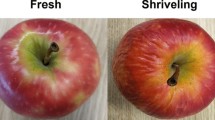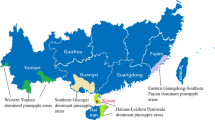Abstract
Two North Dakota breeding clones, ND860-2 and ND2221-6 accumulate very little reducing sugar in low temperature storage and will produce acceptably colored chips with little reconditioning. Progeny from diallel crosses of ND860-2, ND2221-6, Norchip and Kennebec were evaluated for reducing sugar and total sugar accumulation after 100 days of cold storage (3–4°C). Crosses of the North Dakota clones with Norchip or Kennebec produced families whose distributions were skewed towards the high parent with respect to reducing sugar values; about 2% had levels near the two low parents. Crosses between ND860-2 and ND2221-6 produced reciprocal families in which an average of 8% of the progeny had levels as low as these two parents.
Similar content being viewed by others
Literature Cited
Burton, W.G. 1978. The physics and physiology of storage. pp. 545–601.In. The Potato Crop. P.M. Harris (Ed.) Chapman and Hall, London. 730 p.
Coffin, R.H., R.Y. Yada, K.L. Parkin, B. Grodzinski and D.W. Staley. 1987. Effect of low temperature storage on sugar concentrations and chip color of certain processing potato cultivars and selections. J Food Sci 52(3):639–645.
Gould, W.A., B. Hair and A. Baroudi. 1979. Evaluation of potato cultivars before and after storage regimes for chipping. Am Potato J 56:133–144.
Habib, A.T. and H.D. Brown. 1957. Role of reducing sugars and amino acids in the browning of potato chips. Food Technol 11:85–89.
Isherwood, F.A. 1973. Starch-sugar interconversion inSolanum tuberosum. Phytochemistry 14:83–84.
Johansen, R.H. 1986. NDSU Potato Breeding Program. Valley Potato Grower 52(101):32–33.
Johansen, R.H., S.H. Jansky, B. Farnsworth, A. Thompson, D.C. Nelson, N.C. Gudmestad, G. Secor and P. Nolte. 1987. North Dakota Report, National Potato Germplasm Evaluation and Enhancement Report, 1986. pp. 162-174. USDA-ARS-BARC, Beltsville, MD.
Lauer, F. and R. Shaw. 1970. A possible genetic source for chipping potatoes from 40°F storage. Am Potato J 47:275–278.
Mazza, G. 1983. Correlations between quality parameters of potatoes during growth and long-term storage. Am Potato J 60: 145–159.
Nelson, N. 1944. A photometric adaptation of the Somogyi method for the determination of glucose. J Biol Chem 153: 375–380.
Pollock, C. J. and T. ap Rees. 1975. Activities of enzymes of sugar metabolism in cold-stored tubers ofSolanum tuberosum. Phytochemistry 14: 613–617.
Schwimmer, S., C. E. Hendel, W.O. Harrington and R. L. Olson. 1957. Interrelation among measurements of browning of processed potatoes and sugar components. Am Potato J 34:119–132.
Sowokinos, J. R. 1978. Relationship of harvest sucrose content to processing maturity and storage life of potatoes. Am Potato J 55: 333–344.
Author information
Authors and Affiliations
Rights and permissions
About this article
Cite this article
Ehlenfeldt, M.K., Lopez-Portilla, D.F., Boe, A.A. et al. Reducing sugar accumulation in progeny families of cold chipping potato clones. American Potato Journal 67, 83–91 (1990). https://doi.org/10.1007/BF02990958
Accepted:
Issue Date:
DOI: https://doi.org/10.1007/BF02990958




